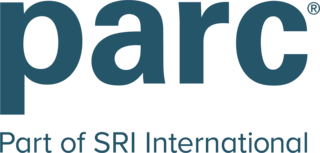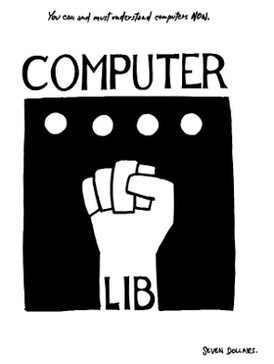External links
- MIT Press printed a revised edition of "Tools for Thought" in April 2000.
- Rheingold.com has the original 1985 text available online.
Tools for Thought: The History and Future of Mind-Expanding Technology is a work of "retrospective futurism" in which Smart Mobs author Howard Rheingold looked at the history of computing and then attempted to predict what the networked world might look like in the mid-1990s. The book covers the groundbreaking work of thinkers like Alan Turing, John von Neumann, and J.C.R. Licklider, as well as Xerox PARC, Apple Computer, and Microsoft (when Microsoft was "aiming for the hundred-million-dollar category"). Rheingold wrote that the impetus behind Tools for Thought was to understand where "mind-amplifying technology" was going by understanding where it came from.

Microserfs, published by HarperCollins in 1995, is an epistolary novel by Douglas Coupland. It first appeared in short story form as the cover article for the January 1994 issue of Wired magazine and was subsequently expanded to full novel length. Set in the early 1990s, it captures the state of the technology industry before Windows 95, and anticipates the dot-com bubble of the late 1990s.

PARC is a research and development company in Palo Alto, California. Founded in 1969 by Jacob E. "Jack" Goldman, chief scientist of Xerox Corporation, the company was originally a division of Xerox, tasked with creating computer technology-related products and hardware systems.
System software is software designed to provide a platform for other software. Examples of system software include operating systems (OS).

A smart mob is a group whose coordination and communication abilities have been empowered by digital communication technologies. Smart mobs are particularly known for their ability to mobilize quickly.

Howard Rheingold is an American critic, writer, and teacher, known for his specialties on the cultural, social and political implications of modern communication media such as the Internet, mobile telephony and virtual communities.

The Whole Earth Catalog (WEC) was an American counterculture magazine and product catalog published by Stewart Brand several times a year between 1968 and 1972, and occasionally thereafter, until 1998. The magazine featured essays and articles, but was primarily focused on product reviews. The editorial focus was on self-sufficiency, ecology, alternative education, "do it yourself" (DIY), and holism, and featured the slogan "access to tools". While WEC listed and reviewed a wide range of products, it did not sell any of the products directly. Instead, the vendor's contact information was listed alongside the item and its review. This is why, while not a regularly published periodical, numerous editions and updates were required to keep price and availability information up to date.
Social computing is an area of computer science that is concerned with the intersection of social behavior and computational systems. It is based on creating or recreating social conventions and social contexts through the use of software and technology. Thus, blogs, email, instant messaging, social network services, wikis, social bookmarking and other instances of what is often called social software illustrate ideas from social computing.
In computer programming, Intentional Programming is a programming paradigm developed by Charles Simonyi that encodes in software source code the precise intention which programmers have in mind when conceiving their work. By using the appropriate level of abstraction at which the programmer is thinking, creating and maintaining computer programs become easier. By separating the concerns for intentions and how they are being operated upon, the software becomes more modular and allows for more reusable software code.

Intelligence amplification (IA) refers to the effective use of information technology in augmenting human intelligence. The idea was first proposed in the 1950s and 1960s by cybernetics and early computer pioneers.

Computer Lib/Dream Machines is a 1974 book by Ted Nelson, printed as a two-front-cover paperback to indicate its "intertwingled" nature. Originally self-published by Nelson, it was republished with a foreword by Stewart Brand in 1987 by Microsoft Press.
Eugene Shallcross Ferguson was an American engineer, historian of technology and professor of history at the University of Delaware, particularly known for his 1992 work Engineering and the Mind's Eye.

Microsoft Silverlight is a discontinued application framework designed for writing and running rich internet applications, similar to Adobe's runtime, Adobe Flash. A plugin for Silverlight is still available for a very small number of browsers. While early versions of Silverlight focused on streaming media, later versions supported multimedia, graphics, and animation, and gave support to developers for CLI languages and development tools. Silverlight was one of the two application development platforms for Windows Phone, but web pages using Silverlight did not run on the Windows Phone or Windows Mobile versions of Internet Explorer, as there was no Silverlight plugin for Internet Explorer on those platforms.
Visual Studio Tools for Office (VSTO) is a set of development tools available in the form of a Visual Studio add-in and a runtime that allows Microsoft Office 2003 and later versions of Office applications to host the .NET Framework Common Language Runtime (CLR) to expose their functionality via .NET.
Family.Show is a free and open-source genealogy program written in C# and running on the .NET Framework. Microsoft partnered with and commissioned Vertigo Software in 2006 to create it as a reference application for Microsoft's latest UI technology and software deployment mechanism at the time, Windows Presentation Foundation and ClickOnce. The source code has originally been published on Microsoft's CodePlex website. It has since been forked and development continues independent of Microsoft on GitHub.

Microsoft Ignite is an annual conference for developers and IT professionals hosted by Microsoft. It has taken place in several locations around the world. The first conference, then known as TechEd, happened in 1993 in Orlando, Florida, United States. The 2014 TechEd in Barcelona marked the last event using that name. Microsoft altered its conference schedule and introduced the Microsoft Ignite name from 2015 on.
ChronoZoom is a free open source project that visualizes time on the broadest possible scale from the Big Bang to the present day. Conceived by Walter Alvarez and Roland Saekow and developed by the department of Earth and Planetary Science at the University of California, Berkeley in collaboration with Microsoft Research and Moscow State University, Alvarez unveiled the first ChronoZoom prototype at UC Berkeley's 2010 Faculty Research Lecture. Although that demo is no longer available to the public online, a second version rewritten in HTML5 is now available and open source. ChronoZoom was inspired by the study of Big History, and it approaches the documentation and visualization of time and history in the same way that Google Earth deals with geography. ChronoZoom allows users to see the true scale of time over cosmic, geologic, biological and social periods.

Satya Narayana Nadella is an Indian-American business executive. He is the executive chairman and CEO of Microsoft, succeeding Steve Ballmer in 2014 as CEO and John W. Thompson in 2021 as chairman. Before becoming CEO, he was the executive vice president of Microsoft's cloud and enterprise group, responsible for building and running the company's computing platforms.

Server Core is a minimalistic Microsoft Windows Server installation option, debuted in Windows Server 2008. Server Core provides a server environment with functionality scaled back to core server features, and because of limited features, it has reduced servicing and management requirements, attack surface, disk and memory usage. Andrew Mason, a program manager on the Windows Server team, noted that a primary motivation for producing a Server Core variant of Windows Server 2008 was to reduce the attack surface of the operating system, and that about 70% of the security vulnerabilities in Microsoft Windows from the prior five years would not have affected Server Core. Most notably, no Windows Explorer shell is installed. All configuration and maintenance is done entirely through command-line interface windows, or by connecting to the machine remotely using Microsoft Management Console (MMC), remote server administration tools, and PowerShell.
ConceptDraw OFFICE is a proprietary office software suite of business productivity tools, developed by Computer Systems Odessa for use with either Microsoft Windows and macOS operating systems. ConceptDraw OFFICE is composed of mind mapping, project management and business diagramming tools. The three components use the cross-format exchange technology, allowing users to employ a visual approach to information management whereby the same set of data can be shown as a mind map, Gantt chart, or business graphic design.

Design tools are objects, media, or computer programs, which can be used to design. They may influence the process of production, expression and perception of design ideas and therefore need to be applied skillfully.